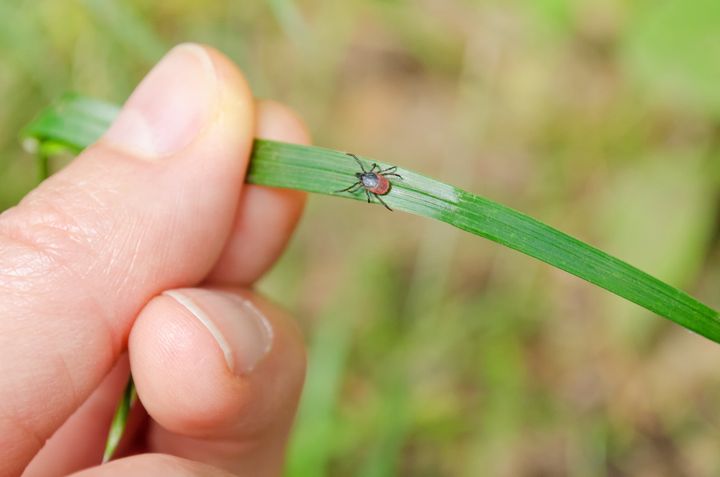You’ve probably heard of Lyme disease, the tick-borne illness that is known to infect people and dogs who spend time outside. But Lyme disease is only one of a number of tick-borne diseases that can infect humans.
Cases of Lyme disease are rising in the United States, along with cases of babesiosis, another tick-borne disease that tends to crop up in the spring and summer. According to Edouard Vannier, an infectious diseases researcher at Tufts Medical Center in Massachusetts, there are about 2,400 to 2,500 reported cases of babesiosis each year in the U.S. That is just the number of reported cases. Many go unreported, which means the actual number of babesiosis infections is likely much higher. (Based on predictions, up to 38,000 cases of babesiosis may occur each year in the U.S., Vannier said.)
Comparatively, there are 30,000 reported cases of Lyme disease each year in the country, according to the Centers for Disease Control and Prevention. (And, again, the number of Lyme disease infections is likely much higher — the CDC estimates up to 476,000 people may be infected with Lyme disease.)
While Lyme disease is clearly a more prevalent problem throughout the country, babesiosis cases are on the rise and can lead to serious health issues if left untreated. Below, experts share what babesiosis is and how to spot the symptoms.
Like Lyme disease, babesiosis is spread via the deer tick.
According to Vannier, “Babesiosis is an infectious disease caused by parasites that invade red blood cells.”
Specifically, the parasite that causes babesiosis in the US is babesia microti, and it’s spread through deer tick bites, he said. But some human babesiosis infections have been caused by other babesia species, too, according to the CDC.
Deer ticks are commonly infected with both of the pathogens that cause Lyme disease and babesiosis, which means co-infection in humans is also common, according to Karine Le Roch, the director of the Center for Infectious Disease and Vector Research at the University of California, Riverside.
But there are more cases of Lyme disease than babesiosis because babesiosis needs the help of Lyme disease to spread, Vannier said.
So, while not all Lyme disease infections also mean you have babesiosis, it is important to know that it is common. Additionally, those who are infected with both have a greater number of symptoms and have a longer duration of disease, Vannier said. Lyme disease symptoms include a bulls-eye rash, fever, fatigue, joint stiffness and muscle weakness, according to the Mayo Clinic.
Babesiosis causes flu-like symptoms in most people.
“The symptoms are very wide. I’d say it can range from asymptotic to life-threatening disease,” Le Roch said.
Most people experience flu-like symptoms, which makes the disease very hard to detect, especially with COVID-19, norovirus and the actual flu continuing to infect people.
“You have a bit of fever, fatigue, headache, chills, sometimes nausea — but in most [cases], it’s resolved and then in a couple of weeks you can feel better,” Le Roch said.
In other words, there aren’t telltale signs that signify this disease, which means it often goes unreported and untreated. Vannier said that some people report muscle aches and a loss of appetite as well. People can also experience vomiting or diarrhea, which is indicative of serious disease.
“You have to be aware that you can indeed have babesiosis and the symptoms might not be warning you,” Vannier said.
The unfortunate catch is that the treatment for the illness is different from Lyme disease treatment, which means it’s important to be aware if you do have it.
For immunocompromised people and elderly folks, the symptoms can be more severe.
“The issue here is that some people will have mild disease … and some of them will actually have very severe disease that will progress into complications, and these patients have to be admitted,” Vannier noted.
For healthy people under 50, your body will likely be able to fight off the disease without any issue, he said. For those 50 and over and those who are immunocompromised, treatment is more often needed.
There are some additional risk factors that you should be aware of — people who do not have a spleen are at risk for severe babesiosis, which can be fatal in those cases, Vannier stressed. Those living with health conditions that affect the immune system, like those going through cancer treatment or living with HIV, can have a hard time fighting off infections of all sorts, including a babesiosis infection.
The longer babesiosis lingers in one’s system, the more of an opportunity it has to mutate and become resistant to the drug therapies that are used for treatment, Vannier added. (There is currently no vaccine.) The most common complication is kidney failure.
That said, it’s important to remember that most people’s immune systems can handle this disease. “It’s only a very few cases that reach this life-threatening disease because most of the healthy people will be fine,” Le Roch said.
The disease is prevalent in certain parts of the Northeast, upper Midwest and the West Coast.
Vannier said the first U.S. case of babesiosis caused by babesia micorti was found on Nantucket, an island in Massachusetts, in the late 1960s.
“It was actually known at that time as Nantucket fever … It was also known as the summer flu because, obviously, it is [a] seasonal disease that is most often seen from late May to late September,” he said.
Following this, it spread to Martha’s Vineyard, and along the coastline of Massachusetts, Rhode Island and Connecticut. In 2000, it spread to the Hudson Valley region of New York and has since spread north to Boston, the North Shore in Massachusetts, southern Maine, southern New Hampshire and southern Vermont. There are also some cases in New Jersey, Pennsylvania and Washington, D.C., Vannier said.
Additionally, cases have been reported in the upper midwest, like Minnesota and Wisconsin. Le Roch added that cases have also been reported in California, Washington and Oregon.
“You need kind of a wet, warm climate and you need some forest and grass and bushes to actually find these ticks,” Le Roch said.
To protect yourself from ticks, you have to be diligent.
“Spring is already here — cases usually start showing up in late May,” which means people are exposed beginning in late April, Vannier said. (Babesiosis has an incubation period of one to four weeks.) As mentioned above, tick season runs through late September.
To avoid ticks, Vannier recommends staying away from long grass by walking on clear trails, in addition to wearing long pants, long-sleeved shirts and socks when out. Additionally, bug repellant is a good tool to keep ticks at bay.
Le Roch said you should check your entire body after being outside in grassy areas, and showering can help wash away any ticks that aren’t attached to you. If you do find an attached tick, remove it immediately with tweezers, she said.
“If you feel sick or weak one to six weeks after the bite of the tick, you definitely have to consult your health provider, and let them know you’ve been walking in the wild and you may have either Lyme or babesiosis,” Le Roch said.


